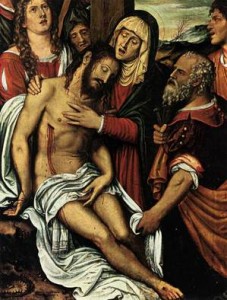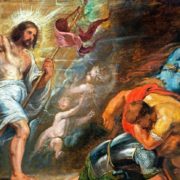 Even as we prepare to celebrate the Resurrection of Jesus Christ on Easter Sunday, this Holy Saturday is a good time to examine the reality of Jesus’ death and burial. It has become necessary to do this because both events have been denied by skeptics over the years. It is also important because, in order for Christianity to be true, Jesus must have died, for without his death there could not have been a Resurrection. He also must have been buried, because scripture and the Church have constantly asserted this fact as part of the kerygma.
Even as we prepare to celebrate the Resurrection of Jesus Christ on Easter Sunday, this Holy Saturday is a good time to examine the reality of Jesus’ death and burial. It has become necessary to do this because both events have been denied by skeptics over the years. It is also important because, in order for Christianity to be true, Jesus must have died, for without his death there could not have been a Resurrection. He also must have been buried, because scripture and the Church have constantly asserted this fact as part of the kerygma.
1. The death of Jesus. Scholar Gary Habermas states that “the death of Jesus is the most recorded event in ancient, non-Christian history” (The Historical Jesus, p. 281). In an earlier post, we looked at Habermas’ use of the Roman historian Tacitus to this effect. Here is another quote from another, non-Christian source, referring to the death of Jesus (there are numerous Christian references to this as well, but I find secular sources are often more convincing to secular people). This one is from the Jewish Talmud, which was compiled between AD 70-200:
“On the eve of the Passover, Yeshu was hanged. For forty days before the execution took place, a herald went forth and cried, ‘He is going forth to be stoned because he has practiced sorcery and enticed Israel to apostasy. Any one who can say anything in his favour, let him come forward and plead on his behalf.’ But since nothing was brought forward in his favour he was hanged on the eve of the Passover!”
– Quoted in Habermas, The Historical Jesus, p. 203
2. The burial of Jesus. Affirming this fact is necessary due to theories like that of former Catholic priest John Dominic Crossan, who famously claimed that Jesus’ dead body was likely thrown into a shallow common grave, where it was eaten by dogs. While not denying that at times in late antiquity, the Romans would leave bodies on crosses to be mauled by animals and birds of carrion (as a public deterrent to revolt), there is no chance this happened to Jesus, because it was peacetime. For Pilate to have left Jesus’ body hanging on the cross overnight during Passover would have been a fatal mistake, all but guaranteeing a riot by the myriad Jews gathered in Jerusalem for the feast. The Romans never would have risked offending Jewish sensibilities here, which they respected during times of calm. Leaving Jesus’ body on the cross would have defiled the land (see Deut. 21:22-23), making it impossible for Jews to celebrate the feast in an acceptable manner. No, Jesus did receive a proper burial with the help of Joseph of Arimathea, an undoubtedly historical reference (no early Christian would have invented a story of Jesus receiving a proper burial, not from his followers, but from a member of the very council that condemned him).



There are a number of misleading errors in the article.
While the Talmud tradition traces back to the 1st century C.E., it wasn’t codified until the 5th century C.E. That means that the final form of polemics against Yesh”u are [a] somewhat vague to avoid Church censuring and persecution and [b] is directly aimed at the 2nd-4th century Hellenist Roman (Christian) image of Yesh”u, by then extensively redacted and Hellenized, INSTEAD OF the original 1st-century Pharisee Jew Ribi.
Most Jews I know, most of whom are Orthodox, accept the death and burial of 1st-century Pharisee Jew Ribi. It’s the supernatural bodily resurrection and divinity that we reject. Contrary to your article, death and burial do NOT imply any κηρυγμα (keirugma; a proclamation by a herald) of any supernatural bodily resurrection or divinity. Talmud reflects the rejection of the Christian man-god image of Yesh”u as a divinity. No authentic references to the 1st century Pharisee Ribi Jew survived the Churches book-burnings and persecutions. In fact, the hard evidence is that his ossuary, and those of his immediate family, were found in 1980 (see “The Lost Tomb”) and their bones re-interred by Ultra-Orthodox Jews in Yerushalayim. (Click the “Burning Issues” buttons in the “Mashiakh” pages of the History Museum of the only Netzarim website at http://www.netzarim.co.il in Israel.) The false charges of forgery have been thrown out by the courts and the world’s top geological scientist has demonstrated that those who mounted charges of forgery were incompetent and wrong. (also thoroughly, impeccably and indisputably documented in the same pages of our History Museum).
The article is also ignorant of 1st century Judaism and mistaken in asserting that his wealthy student from Rantis, Yoseiph, was a member of the same Beit Din that condemned him. This is patently wrong. There were a number of different Batei Din in Yerushalayim at that time. Being a Ribi demonstrates that Yehoshua was a Perushi (Pharisee). Being a disciple of a Perushi demonstrates that Yoseiph of Rantis was also a Perushi. It has been demonstrated by a number of scholars that the Perushim defended the followers of Ribi Yehoshua long after his death; even well after the death of his brother and first Paqid of the Netzarim, Paqid Yaaqov ha-Tzadiq. It was a Beit Din of Tzedoqim (Sadducees), Hellenists who were collaboraters with the Hellenist Roman occupiers, who turned him over to the Romans alleging that he claimed to usurp Caesar as “god”; for which the Romans executed him.
Goodness! How bitter some seem when confronted with the truth! Rewrites of history based upon questionable scholarship are not believable when these tidbits confront the phenomenon of the ‘explosion’ of the Christ’s new Church. As Cale said quite correctly, the Apostles would hardly subject themselves to martyrdom in support of a such a fabrication.
Cale!
You were awsum last night on EWTN.
God Blessing in all you do!
John
«La Junta pro ya ha saldado las deudas con Nuestra Madre,
Esperanza, Vía Crucis y Santurrón Entierro», confirmó Martín Alén.